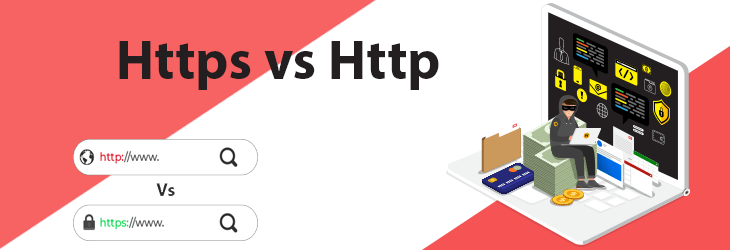
You added items to your cart and you just click to check out and make the payment. But suddenly your address bar goes from HTTP to HTTPS. Sometimes a lock hanging with a different font colour also appears in the address bar. What’s going on?
While casual users barely notice it, it is a difference worth noticing as the two protocols, at the start of the URL, showcase significant difference in the web pages you visit and the website performance. If you never noticed this, then we bet this information will expand new horizons as you can consider this as the first lesson of internet security.
What is HTTPS?
HTTP and HTTPS, both, are used to exchange information between a web server and a browser. Well, the presence of the extra ‘S’ simply stands for Secure. This means, the data entered on HTTPS is encrypted and secured.
Wondering why you need security for the web?
HTTP is used widely to exchange data on the World Wide Web. But, it is not secured, if intercepted then anyone can have an access to the data easily. Think of the customer information you just entered while shopping online, or the credit/debit card details. Let’s say you are using public Wi-Fi at the airport. If you are not connected to a secure server, then anyone can read your information and the ‘man in the middle’ can steal your personal information. So to save yourself from such attacks, you need encryption. This is why as soon as you proceed to checkout, the address bar automatically gets redirected to HTTPS, making the data and financial transactions secure. Simply putting, HTTPS is a secured extension of HTTP. It is powered by Transport Layer Security, a standard technology driven security and upgraded version of Secure Sockets Layer. Besides encrypting data, TLS authenticates the connected server and also protects the data. Web browsers like Google Chrome, Firefox usually have a padlock in their address bar to indicate that the HTTPS connection is in effect.
But why do all the websites, including non-transactional ones need to shift to HTTPS?
Google displays HTTPS websites first: Ever since HTTPS was announced as a ranking signal by Google in 2014, the companies who implemented HTTPS improved their rankings with a better page visibility. Over 40% websites on the first page of Google are secured with HTTPS. Google confirmed they support HTTPS sites as they don’t want to send the users to insecure pages. So, if you are still into HTTP, then your website might be outranked by similar sites.
Cyber safety: Upon using HTTPS, the computers agree to a ‘code’ and then the message/ data is jumbled using the code, ensuring safety from the hackers. Authenticating the servers, data protection and encryption are the key features to make sure the data is not readable by ‘man in the middle.’.
Gains trust of customers: The rising concerns towards security and privacy is also one of the benefits of using HTTPS. The customers want to trust the website when they give personal/confidential data, and using HTTPS is one of the ways to win trust. It shows that the data is secured and encrypted, landing them in safe hands.
Updated browser label: In a bid to push secured websites further, Google is also updating the way it labels HTTP sites in Google Chrome. Presently, HTTP sites have a grey information symbol telling the visitor that the site is insecure. However, they are planning to update and include a ‘not secure’ label in the URL itself. Eventually all the HTTP pages will show a red triangle with Not Secure label in the address bar after the update.
Increased conversion rates: The users currently do not have a complete technical understanding of HTTPS connection. However, they understand that site should be HTTPS when providing personal information. We already see a difference in conversion rates when compared HTTP to HTTPS. After Google updates the new label, the users will become more aware and curious seeing a red mark saying ‘insecure’ in the address bar. That will further widen the conversion rates.
How to switch from HTTP to HTTPS?
The internet has almost 4 billion users. And the combination of conscious users, awareness of internet security and encouragement from web browsers, indicates that the full transition from HTTP to HTTPS might happen soon. If you are ready to make the significant switch to improve your website’s performance then let BluBrandz Technologies handle the procedure for you. Our expert team can help you switch to HTTPS or add a secured layer to your website. If any queries, Contact us today
